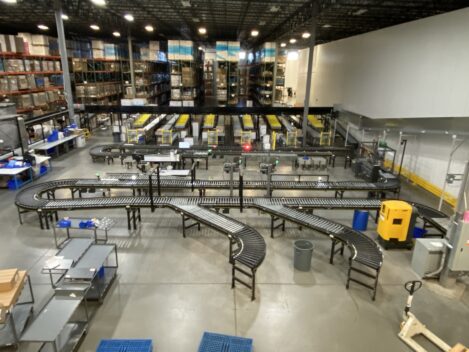The advantages of implementing a new conveyor system are more than simple efficiency gains; they encompass a wide range of benefits that impact warehouse operations from day one. From expanding storage potential to mitigating labor shortages, the advantages of implementing a conveyor system are substantial. By allowing current employees to transition to other areas of the warehouse, a conveyor system immediately addresses labor shortages, thereby enhancing safety and efficiency. Below are four types of conveyors to optimize your operations solutions and break down how they work, and the unique benefits tied to their design.
 1.Sortation Conveyors:
1.Sortation Conveyors:
These systems streamline the process of moving products to specific destinations by merging, identifying, inducting, and separating them efficiently. Sortation conveyors offer flexibility and can be customized to suit your facility’s unique needs, whether it’s managing high throughput rates or accommodating space limitations. When choosing a sortation conveyor, consider factors such as capacity, speed, material handling needs, layout, and maintenance requirements.
Sorters: Apart from sortation in, cross-belt sorters are powered conveyors using 90-degree angles to sort products off conveyor. Not all cross-belt sorters use high-speed trays or trays at all; they use a carrier. Cross-belt sorters are efficient, easy to operate and effortlessly quiet. So quiet in fact that some warehouses need a light to signal when the cross-belt sorters are turned on. Another sorter known for low maintenance and quiet operation is Shoe Sorters. These types of sorters slide products to designated locations, making them perfect for fragile items in the retail industry.
 2.Gravity (Non-Powered) Conveyors:
2.Gravity (Non-Powered) Conveyors:
These conveyors are ideal for packaging, pallet handling, assembly, and truck off-loading sites. Gravity conveyors require no power and can be seamlessly integrated into warehouses of all sizes. These solutions operate without the need for motor power sources, typically relying on a decline or manual force to move loads along its path. Some examples of non-powered gravity conveyor are Skatewheel Conveyor or Roller Conveyor.
These systems feature wheels or rollers integrated into channel frames, which are held together with “bed spacers.” They can be customized to various widths, with frame options available in both steel and aluminum materials. The main difference between these is what kind of items they can hold. For skaters, an operation would lean more on boxes, carries, crates, sheets; really any items with a smooth, flat bottom. As for the roller conveyor systems, these items could be uneven or even open at the bottom like wire bins, wood boxes, canisters, lumber, blocks, etc. Roller conveyors are typically more expensive than Skatewheel but can be more effective depending on what product is being moved.
 3.Live Roller Conveyors:
3.Live Roller Conveyors:
Economical and low-maintenance, Live Roller conveyors are versatile options suitable for a wide range of industries. Live-Roller uses power to propel products down the line in boxes or totes. This solution is keener toward medium-to-large size products, making this one of its main benefits.
Live-Roller conveyors are perfect for adapting to a variety of industries or multiple-size products within one company. They can be powered by v-belts, flat conveyor belts, chains, round belts, or motorized pulleys, giving options to your warehouse’s operation and room to personalize your solution. Implementing this type of conveyor will solve light-to-medium package handling problems, automatically increasing order throughput, and decreasing packaging errors.
4. Zone Routing Conveyors: 
Zone routing conveyor systems are essential for modern warehouses and distribution centers, optimizing package guidance through specific pick zones to enhance productivity and reduce congestion. These intelligent systems facilitate faster carton movement, making them ideal for high-volume operations all while decreasing labor time, “dead zones” and operation deficiencies. Warehouse Management Systems (WMS) and Warehouse Control Systems (WCS) work incredibly well with zone routing conveyors. They provide real-time feedback and streamline order processing, significantly reducing operator handling time.
When selecting a zone routing conveyor, consider factors such as material type, speed requirements, workspace layout, and maintenance needs. These systems are best suited for busy, high-output environments with limited personnel.
No stress, we’ll do the rest

 Skip to main content
Skip to main content

 3.
3.





